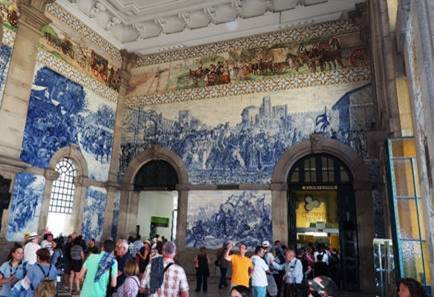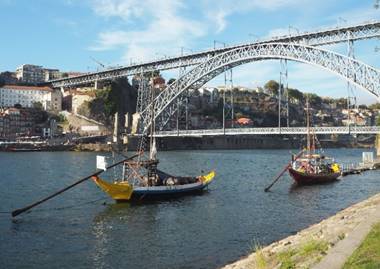13 Aug - Shiny tiles and cobbled streets V5

|
41:11.2N 008:42.35W The wind blew on
Thursday too, so nobody left the marina at Leixoes and we
went ashore in the rubber boat to discover the city of Porto
instead. It’s a brisk walk round the edge of the busy port
of Leixoes to the market at Matosinhos where you exchange a
couple of shiny coins for a seat on the bus into Porto. The
500 route runs along the coast, through typical seaside
suburbs with names like ‘Praia de Ingles’. At the entrance
to the River Douro, the scenery changes significantly.
There is one of those low slung Portuguese forts which seems
to hug the topography rather than dominate it, but suddenly
you are into a fine river with boats on moorings, tree-lined
quaysides interspersed with tiny sandy beaches, a glimpse of
a high bridge with brightly coloured rooves beyond, and
houses covered in glazed tiles.
Porto from the bus The architecture is the
biggest surprise: in Spain, they mercilessly knock down the
old buildings and replace them with functional but faceless
apartment blocks. Not here: not much extends above five
storeys, wrought iron railings guard every window, begonias
blossom on every sill and the low doorways invite you into a
cavernous granite interior. The rooves are terracotta, the
walls either colourful tiles or whitewash – or both. It’s
very attractive.
Echoes of San Francisco? The city centre is a
couple of miles up the river, looking across at the vast
warehouses of the port lodges with their names proudly
painted on hoardings reminiscent of the Scottish whisky
distilleries of our 2016 adventures. Porto is a mix of fine
merchants houses, church spires, leafy squares, cobbled
streets and trams. And tourists… but not in the density
that I remember in Barcelona, for example. The river
dominates, but everywhere you look there is a surprise: a
family crouching in a darkened doorway, a bucolic scene in
those blue-painted tiles on a wall, a narrow street climbing
into the sky, a smart boutique, a glimpse of the water, or
the azure blue sky.
Not your average railway
station interior… The bus took us to the
railway station, which is famous for its tiled interior.
Suitably impressed, we wandered forth and spent the rest of
the morning meandering through the cobbles streets. We
crossed the bridge on the high level and then took a cable
car down into the port of Vila Nova de Gaia where we had a
lunch appointment at Graham’s Port Lodge. It has a
wonderful location overlooking the city and we enjoyed one
of the best meals of the trip so far here: the traditional
‘tasting menu’ with accompanying wines – six of them. By
the end, my cheeks were slightly numb, but the combination
of food, wine, port, jolly nice people and a beautiful
location was pretty much… perfect.
Graham’s Port Lodge
restaurant It reminded us of the
Louis Vuitton-owned Ardbeg Distillery on Islay, but Graham’s
restaurant and marketing suite seems more sophisticated (and
reassuringly expensive!). We enjoyed ourselves over lunch
so much that we missed our 4pm tour, but they slotted us
into the next one without a murmur. To be honest, the tour
itself was not as interesting as the whisky distilleries,
but the history and the story of port, Britain, the Douro
river, the vineyards in the mountains and (jn this case) a
dynamic Scottish family, the Symingtons, made up for the
rather straightforward presentation of manufacturing the
sticky red stuff. I have not bought any yet…
Proof that we did make
it to the tour… On Friday, we finally
made it into the marina. We celebrated with a ‘clean ship’
day and made plans for the rest of our stay here. Saturday, we returned to
Porto to see more of this fabulous city. The Palacio de
Bolsa is actually the Chamber of Commerce and not a palace
at all. Its status reflects the unique blend of port, cod
and trade that made this such a powerful city on the Iberian
peninsula. It is still the industrial capital of Portugal
and until 1997 it has its own Stock Exchange in the
Palacio. The merchants of the city, dominated by the port
producers, clearly had an unusual relationship with the
dictator Antonio Salazar, who ruled Portugal for over thirty
years until his death in 1968. Aligned with Franco on many
issues, he seems to have had a reasonably positive influence
on the country overall. It’s interesting to reflect then,
on Portugal’s relationship with Britain. Often touted as
our oldest ally, I’m not aware that they have helped us that
much since the Peninsular War against Napoleon (although
Salazar did bring them into NATO) but the alliance is
clearly a commercial one: Portugal lies on the key trade
routes to the Mediterranean, the Far East and the New World
(particularly in the age of sail, when ships did exactly
what Escapade is doing and would have called here for water
and essential supplies – with port being a staple part of
the Royal Navy’s diet for several hundred years). The
building is very impressive and as clear a statement as you
could wish for that the city was prosperous, confident and
open for business…
Inside the Palacio de
Bolsa – a room built to impress Middle Eastern customers Lunch was a less
glamorous affair than our last effort at Graham’s Port
Lodge: we found a tiny café in a narrow cobbled street
providing suckling pig sarnies and salt cod in various
combinations, lubricated with Galician beer. Delicious and
all for under €20. Later we visited the 13th
century church of Sao Francisco, with its extraordinary gold
interior – 200kg of gold leaf adorns the columns and
ceiling. I struggle with this: on the one hand, the
benefactors wanted to glorify God and we all need cheering
up, so why SHOULD it be dull and uninteresting inside? On
the other hand, surely the money could have been spent
improving the circumstances of the needy?
The Dom Luis 1 Bridge
over the Douro at Porto was designed by Gustav Eiffel’s
company In the afternoon, we
meandered. It was splendid, although irritatingly we seemed
to find small, cheap launderettes at every corner. Don’t
they own washing machines here? We sat in a bar and watched
some students performing lively folk songs to some bemused
tourists. We crossed the bridge back into Vila Nova de
Gaia, planning to visit the Ramos Pinto Lodge, but it shut
at seven so we pushed inland and found a tiny restaurant off
the tourist track selling basic Portuguese food at a basic
price. We devoured an octopus between us and caught the
last bus back to Leixoes.
Café culture and
community singing… Sunday was a maintenance
day. Self maintenance and some major surgery on the teak
deck in the cockpit. We plan to spend the next couple of
days sitting in a hire car, so the caulking should have time
to go off before we sail for Lisbon. The verdict on Porto?
It fully deserves its status as a UNESCO World Heritage site
and is a great location for a 3-day city break. Highly
recommended! |








